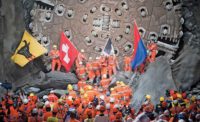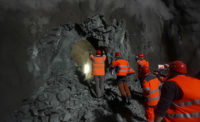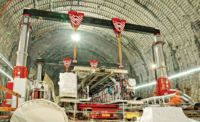Seventeen years of construction on the world’s current longest tunnel, through the Alps, formally ends on June 1, when the Swiss Federal Railways takes charge of the 57-kilometer-long, twin-bore Gotthard base tunnel. With two of the three major tunnels of the New Railway Link through the Alps (NRLA) program now done, only the 15.4-km-long Ceneri base tunnel is still being built.
Since starting the Gotthard work in May 2003, four TBMs displaced some 10.5 million cu meters of rock while boring 75% of the 150 km of tunnel drives—the rest was by drill-and-blast. A $1.7-billion railroad-systems contract followed the civil work, leading to this week’s handover before heads of state and other dignitaries.
The Gotthard alone will shave 30 minutes from the roughly 300-km Zurich-Milan rail journey. Another 30 minutes will be clipped off the journey when the Ceneri tunnel, to the south, opens in 2020.
A 2013 legal challenge over the Ceneri fit-out contract delayed that opening from 2019, according to the project owner, AlpTransit Gotthard S.A., Lucerne, Switzerland.
Since the long and complicated NRLA program started, all planned handover dates have shifted and in both directions. Working up to 2 km below the mountain surface in variable rock as hot as 50°C was never to be trouble-free.
In 1993, when key geological investigations were starting, the target handover date was 2007, says AlpTransit’s chief spokesman Ambros Zgraggen. After work started in 1999, that date shifted to 2012. Over the years, the handover target slipped to 2014, then to 2017, before improving to this year.
Meanwhile, the Gotthard’s construction-cost forecast rose to around $10 billion today from $6 billion in 1998 at constant prices, says Zgraggen.
Conceived soon after Word War Two, the Gotthard is the largest of three rail tunnels in the NRLA. The 34.8-km-long Lötschberg was the first to open, in December 2007. The Swiss parliament in 1998 approved a total NRLA budget of $19.2 billion, including $13.4 billion for all aspects of the Gotthard.
The Gotthard’s twin bores are set some 40 m apart and linked with cross passages at 325 m intervals. Most of the tunneling was done with four hard-rock TBMs with diameters ranging from about 8.8 m to 9.6 m
To handle the tunneling, AlpTransit recruited the TAT joint venture for more than half the tunnel—31.4 km—from the south portal, including the Bodio and Fadio sections. Zschokke Locher A.G., Zurich, led the team, which included Salini Impregilo S.p.A., Milan, and Hochtief A.G., Essen, Germany.
The Transco-Sedrun joint venture, led by Batigroup A.G. Tunnelbau, Zurich, built the 8.5-km Sedrun section. Bilfinger & Berger Bau A.G., Munich, and others were also on the team. The AGN joint venture, led by Austria’s Strabag A.G., handled the remaining 19.2 km to the north portal.
AlpTransit started awarding the main tunneling contracts in June 2001, with the first kilometer drilled and blasted that August at Bodio in the south. Machine boring began at Amsteg in March 2003.
Soon after starting, two TBMs hit faulted, brittle rock that was too soft for the Gripper machines, according to their supplier, Germany’s Herrenknecht A.G, Schwanau. The TBMs needed good rock at the rear of the shield to grip and from which to thrust. After months of slow progress, the TBMs left the fault zone in August 2003.
TBM crews completed the 11.3-km Amsteg-Sedrun drives in June and October 2006. Then, the machines were refurbished for the south drive, from the Erstfeld portal to Amsteg, 7.8 km away. They broke through in June and September 2009, achieving a record 56 m advance in 24 hours along the way, according to Herrenknecht.
The southern pair of TBMs completed the 15.9-km Bodio-Faido section in September and October 2006. Then, according to Herrenknecht, their diameters were expanded to 9.4 m. To navigate through the difficult, 150-m Piora Basin, described as funnel-shaped formation containing sugar-like dolomite and high-pressure water. The machines holed through in October 2010 and March 2011.
Construction and engineering teams in August 2013 traveled the full length of the tunnel for the first time on foot, train and bus, taking six hours for the 57-km transit. As part of its railroad systems contract, the consortium Transtec Gotthard placed the last sleeper in October 2014, completing 290 km of track in 39 months.









Post a comment to this article
Report Abusive Comment